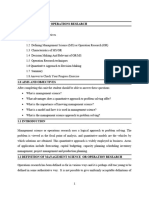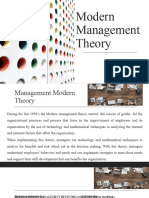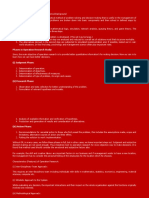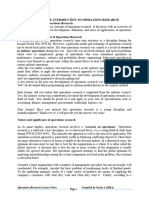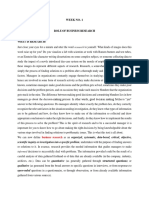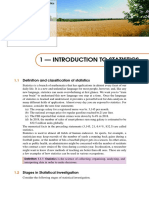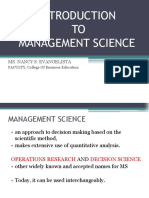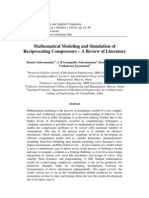OR Chapter-1
OR Chapter-1
Uploaded by
ermias alemeOriginal Description:
Copyright
Available Formats
Share this document
Did you find this document useful?
Is this content inappropriate?
Report this DocumentCopyright:
Available Formats
OR Chapter-1
OR Chapter-1
Uploaded by
ermias alemeCopyright:
Available Formats
Operations Research
CHAPTER ONE
INTRODUCTION TO OPERATIONS RESEARCH
Management science or operations research uses a logical approach to problem solving. The problem is
viewed as the focal point of analysis, and quantitative models are the vehicles by which solutions are
obtained. This quantitative approach is widely employed in business. Areas of application include
forecasting, capital budgeting, capacity planning and scheduling, inventory management, project
management, and production planning.
In this first unit, some of the basic of management science are covered, included answers to such
questions: what is management science? Who uses it? Who use a quantitative approach? What are models
and how they used? And what are the different types of models?
1.1. DEFINITION OF MANAGEMENT SCIENCE OR OPERATIONS RESEARCH
Operations research has been defined so far in various ways and it is perhaps still too young to be defined
in some authoritative way. It is not possible to give uniformly acceptable definitions of OR/MS. A few
opinions about the definition of OR/MS are given below. These have been changed according to the
development of the subject.
Management Science: can be defined as a problem solving process used by an interdisciplinary team to
develop mathematical models that represent simple to complex functions relationships and provide
management with a basis for decision making and a means of uncovering new problems for quantitative
analysis.
Moreover, management science encompasses:
Development of models for specific problems,
It makes a substantial contribution in a much broader area: the application of the output from MS
models for decision making at the lower, middle, and top management levels,
A manager’s experience, upcoming business conditions and the output from a mathematical
models form the best combination for planning, organizing, directing and controlling the
company's activities.
OR is a scientific method of providing executive departments with a quantitative basis for
decisions regarding the operations under their control.
OR is the scientific method of providing executive with an analytical and objective basis for
decisions.
OR is the art of giving bad answers to problems to which otherwise, worse answers are given.
Genous Land University College Page 1
Operations Research
It is a systematic method oriented study of the basic structures, characteristics, functions and
relationships of an organization to provide the executive with a sound, scientific and quantitative
basis for decision making.
OR is a scientific approach to problem solving for executive management.
Management Science: is the application of a scientific approach to solving management problems in
order to help managers make better decisions.
As implied by this definition, management science encompasses a number of mathematically oriented
techniques that have either been developed with in the field of management science or been adapted from
other disciplines, such as the natural sciences, mathematics, statistics, and engineering.
Management Science: is a discipline devoted to solving certain managerial type problems using
quantitative models. This quantitative approach is widely employed in business.
Operation Research: is the application of scientific methods, techniques, and tools to problems involving
the operations of systems so as to provide those in control of operations with optimum solutions to the
problem.
Thus, it may be regarded as the scientific method employed for problem solving and decision making by
the management. The following indicates the significant features of operation research:
Decision making
Scientific approach: it employs scientific methods for the purpose of solving problems, and there is
no place of whims and guess-work in it. It is a formalized process of reasoning.
Objective: it attempts to locate the best or optimal solution to the problem under consideration.
Inter-disciplinary team approach: no single individual can have a through knowledge of the myriad
aspects of OR and how the problems may be addressed.
Digital computer: use of a digital computer has become an integral part of the operations research
approach to decision making.
1.2. CHARACTERISTICS OF MANAGEMENT SCIENCE/OPERATION RESEARCH
There are four major characteristics of management science. These are:
a. Examine Functional Relationships from a Systematic Overview
The activity of one function or part of a company will have some effect on the activity of each of the other
functions or parts. In order to make effective evaluations of decisions or actions in a company, it is
necessary to identify all important interactions and determine their impact on the company as a whole.
Initially, the functional relationships in an MS project are expanded deliberately so that all the
Genous Land University College Page 2
Operations Research
significantly interacting parts and their related components are contained in a statement of the problem. A
systems overview examines the entire area under the manager's control rather than just one specialized
area. This approach provides a basis for initiating inquiries into problems that seem to be affecting
performance at all levels.
b. Use the Interdisciplinary Approach
During the early years of management science there was a great shortage of scientists (mathematicians,
physicists, chemists, engineers and statisticians). The military groups interested in MS at that time had to
hire their personnel not by selection, but by acquisition. Out of this forced approach, management science
comes to recognition of the value inherent to the interdisciplinary team. Although we often speak of
physical problems, chemical problems, biological problems, psychological problems, social problems and
economic problems as though such problems are in some way categorized in nature, the fact is that
various disciplines actually describe different ways of studying similar problems.
c. Uncover New Problems for Studying
A third characteristic of MS, one which is often overlooked is that the solution of an MS problem brings
new problems to light. All interrelated problems uncovered by the MS approach do not have to be solved
at the same time. However, each must be solved with consideration for other problems if maximum
benefits are to be obtained. It can be said that management science is never effectively used when it is
restricted to "one-shot" projects. Its greatest benefits are those obtained through a continuity of research.
d. Uses a Modeling Approach to Problem Solving
MS, like many disciplines, takes a systematic approach to problem solving. Although several approaches
to solving MS problems can be advanced, we may stress the modeling process, in which both manager and
management scientist interact throughout the problem solving process. Great emphasis is placed on the
participation of both these parties in the modeling of the problem, but before examining the details of the
interaction between the manager and the Management Scientist, we will look first at the essentials of
mathematical models and consider some of their advantages and disadvantages.
1.3. DECISION MAKING AND RELEVANCE OF OR/MS
The role of quantitative analysis in the managerial decision making process is perhaps best understood by
considering the decision making process. Note that the process is initiated by the appearance of a problem.
The manager is responsible for making a decision or selecting a course of action will probably make an
analysis of the problem, which includes a statement of the specific goals or objectives, an identification of
constraints, an evaluation of alternative decisions, and a selection of the apparent "best" decision or
solution for the problem.
Genous Land University College Page 3
Operations Research
The analysis process employed by manager may take two basic forms: qualitative and quantitative.
Qualitative Approach to Decision Making
The qualitative analysis is based on primarily upon the manager's judgment and experience.
The type of analysis includes the manager's intuitive "feel" for the problem and is more of an art than a
science.
If the manager has had experience with similar problems, or if the problem is relatively simple, heavy
emphasis may be placed up on qualitative analysis.
However, if the manager has had little experience with similar problems, or if the problem is
sufficiently important and complex, then quantitative analysis of the problem can be a very important
consideration in the managers’ final decision.
It is considered when the decision maker doesn’t have data about the problem.
The skills in qualitative approach to problem solving are inherent in the decision maker.
It is used when the problem under consideration doesn't involve too many variables or it is not
complex, it is not new or familiar, when the cost of the decision is not heavy and when immediate
action is required.
Quantitative Approach to Problem Solving
In this approach, an analyst will concentrate on the quantitative factors or data associated with the
problem and develops mathematical expressions that describe the objectives, constraints and
relationships that exist in the problem.
It is supported by the available data.
It uses mathematical models.
The skills in quantitative approach is acquired by studying the mathematical tools or OR techniques.
It is used under the following situations
o When the problem involves too many variables
o When the problem is new (not familiar)
o When the decision is very important involving a great amount of money
o When the problem is repetitive (unique)
o This approach is believed to reduce time and effort to make decisions.
Both the qualitative and the quantitative analysis of a problem provide important information for the
manager or decision maker. In many cases, a manager will draw upon both sources and, through a
comparison and evaluation of the information, make a final decision.
Genous Land University College Page 4
Operations Research
While skills in the qualitative approach are inherent in the manager and usually increase with experience,
the skills of the quantitative approach can be learned only by studying the assumptions and methods of
management science. A manager can increase decision making effectiveness by learning more about
quantitative methodology and by better understanding its contribution to the decision making process. The
manager who is knowledgeable in quantitative decision making procedures is in a much better position to
compare and evaluate the qualitative and quantitative sources of recommendations and ultimately combine
the two sources in order to make the best possible decision.
1.4. OPERATIONS RESEARCH TECHNIQUES
a. Linear Programming Method
It is primarily concerned with optimum allocation of scarce resources subject to certain limitation. It uses
simplex procedure to solve product mix in portfolio analysis and transportation algorithm.
b. Decision Analysis (Theory)
It is concerned with making decision under conditions of risk and uncertainty. Decision theory represents
a generalized approach to decision making which often serves as the basis for a wide range of managerial
decision making. The decision model includes a list of courses of action that are available and the possible
consequences of each course of action. An important factor in making decision is the degree of certainty
associated with the consequences. This can range anywhere from complete certainty to complete
uncertainty, and it generally affects the way a decision is reached.
c. Network Analysis
It is considered under risk and uncertainty situation, and involves determination of an optimum sequence
of performing certain activities in a project - this is to minimize the overall cost (time).
Networks are important tools of management science. Not only can networks are used to models a wide
variety of problems they can often be solved more easily than other models of the same problem, and they
present models in a visual format. The techniques in network analysis includes PERT, CPM, & Gant
Chart.
d. Inventory Model
It is a model which operates to optimize inventory levels. The main emphasis is minimizing, carrying,
ordering and being out of stock costs.
e. Queuing Model (Waiting Line Model)
It determines the average time spent in line waiting for service.
f. Markov Analysis
It is used to determine the purchasing behavior of customers-brand loyalty of customers- given that the
behavior of customers is known.
Genous Land University College Page 5
Operations Research
Significance of Operation Research
It provides a tool for scientific analysis and provides solution for various business problems.
It enables proper deployment and optimum allocation of scarce resources.
It helps in minimizing waiting and servicing costs.
It enables the management to decide when to buy and how much to buy through the technique of
inventory planning.
It helps in evaluating situations involving uncertainty.
It enables experimentation with models, thus eliminating the cost of making errors while
experimenting with reality.
It allows quick and inexpensive examination of large numbers of alternatives.
In general OR facilitates and improves the decision making process.
Areas of Application
Inventory control
Facility design (distribution decision)
Product mix determination
Portfolio analysis
Allocation of scarce resources
Investment decisions (constructing new plant, expanding programs, sub contracting and the like)
Project management.
1.5. QUANTITATIVE APPROACH TO DECISION MAKING
The role of quantitative analysis in the managerial decision making process is perhaps best understood by
considering the flowchart below:
Qualitative
Analysis
Managerial Summary &
Problem Evaluation Decision
Quantitative
Analysis
Genous Land University College Page 6
Operations Research
We begin our study of quantitative approaches to decision making by considering a five step procedure:
a. Problem definition
The problem definition step is the most critical phase of the quantitative analysis process. It usually takes
imagination, teamwork, and considerable effort to transform a rather general problem description in to a
well-defined problem that can be approached quantitatively.
b. Model development
Models are representations of real objects or situations. These representations or models can be
represented in various forms. They are constructed to make conclusion about the real thing and show the
relationship between an action and reaction or cause and effect. Depending up on the degree of abstraction
model is classified in to three formats:
Iconic Model: it is a physical representation of a system or real object on a different scale than the
original. Example:
- A scale model of an airplane is a representation of a real airplane.
- A child's toy truck is a model of a real truck
Analog Model: it includes those that are physical in form but doesn't have the same physical
appearance as the object being modeled. Example:
- The speedometer of an automobile is an analog model; the position of the needle on the dial
represents the speed of the automobile
- A thermometer is an analog model representing temperature or Barometer for atmospheric
pressure.
Mathematical Model: it is a model which represents a problem or reality by a system of symbols
and mathematical expressions. Example: TR = PQ
The purpose or value of any model is that it enables us to draw conclusions about the real situation by
studying and analyzing the model. For example, an airplane designer might test an iconic model of a new
airplane in a wind tunnel in order to learn about the potential flying characteristics of the full size airplane.
Similarly, a mathematical model may be used to draw conclusions about how much profit will be earned if
a specified quantity of particular product is sold.
Genous Land University College Page 7
Operations Research
Benefits of Models
o Experimenting with models saves a lot of time than the real system.
o Manipulating the model is much easier than manipulating the real system.
o The cost of making errors during the trial and error expert is much smaller when done on the model.
o Model enhances and re-enforces learning
o Model enables quick identification and analysis of solution.
c. Data Preparation
The third step in the process of quantitative analysis is the preparation of the data required by the model.
Data in this sense refer to the values of the uncontrollable inputs to the model. All uncontrollable inputs or
data must be specified before we can analyze the model and select a recommended decisions or solution
for the problem.
d. Model Solution (Solving the Model)
Once the model development and data preparation steps have been completed, we can proceed to the
model solution step. In this step, the analyst will attempt to identify the values of the decision variables
that provide the "best" output for the model. The specific decision variable value or values providing the
best output will be referred to as optimal solution for the model.
e. Report Generation and Implementation
The final step in the quantitative analysis process is the preparation of managerial reports based upon the
model's solution. Thus it is essential that the results of the model appear in a managerial report that can be
easily understood by the decision maker. The report will include the recommended decision and other
pertinent information about the model results that may be helpful to the decision maker. Although the
generation of a managerial report is the final step in the quantitative analysis process, the implementation
of the information contained in the report is a final action that remains to be taken by the manager or
decision maker.
Successful implementation of results is of critical importance to the management scientists as well as the
manager. If the results of the quantitative analysis process are not implemented, the entire effort may be of
no value.
Genous Land University College Page 8
You might also like
- James R. Evans - Statistics, Data Analysis and Decision Modeling International 5th Ed.-Pearson (2013)Document543 pagesJames R. Evans - Statistics, Data Analysis and Decision Modeling International 5th Ed.-Pearson (2013)Danny Lim85% (13)
- LOG307 StudyGuideDocument238 pagesLOG307 StudyGuideNora AbdulNo ratings yet
- The Ecology of Plants by Jessica GurevtichDocument465 pagesThe Ecology of Plants by Jessica GurevtichDana Ammann100% (10)
- Li Zhaoping-Understanding Vision - Theory, Models, and Data-Oxford University Press (2014)Document397 pagesLi Zhaoping-Understanding Vision - Theory, Models, and Data-Oxford University Press (2014)paul m100% (1)
- Ishikawa Diagram: Anticipate and solve problems within your businessFrom EverandIshikawa Diagram: Anticipate and solve problems within your businessRating: 5 out of 5 stars5/5 (3)
- Operation Research Unit 1Document12 pagesOperation Research Unit 1Shalle said AdenNo ratings yet
- Christine Marie Ramirez - Activity - 2Document2 pagesChristine Marie Ramirez - Activity - 2Christine Marie T. RamirezNo ratings yet
- OR Chapter 1&2Document91 pagesOR Chapter 1&2sami damtewNo ratings yet
- Management Science Lesson AutosavedDocument19 pagesManagement Science Lesson AutosavedCygresy GomezNo ratings yet
- Aced 23 Module 1Document15 pagesAced 23 Module 1JessaNo ratings yet
- New Ch1 ORDocument15 pagesNew Ch1 ORWudneh AmareNo ratings yet
- PA 214 Updated Approaches To ManagementDocument187 pagesPA 214 Updated Approaches To ManagementAli HasanieNo ratings yet
- Or Book - Rama MurthyDocument717 pagesOr Book - Rama Murthylulughosh100% (1)
- ORDocument716 pagesORSelva Raj100% (1)
- Management Science Group IDocument9 pagesManagement Science Group Illaneraerika14No ratings yet
- Or NotesDocument56 pagesOr Notesharish srinivasNo ratings yet
- Module-Chapter I-Introduction To Management Science.Document6 pagesModule-Chapter I-Introduction To Management Science.Guenivere FajaritoNo ratings yet
- Operation ResearchDocument25 pagesOperation Researchaishdesai31No ratings yet
- Introduction To Management ScienceDocument5 pagesIntroduction To Management ScienceCheska AgrabioNo ratings yet
- Operation ResearchDocument10 pagesOperation Researchviga1880No ratings yet
- Book 1 ORDocument20 pagesBook 1 ORMslkNo ratings yet
- MODULE FOR MGMT 31 Lesson 1 3Document30 pagesMODULE FOR MGMT 31 Lesson 1 3Rotsen SebiosNo ratings yet
- Management ScienceDocument2 pagesManagement ScienceJianne AlegreNo ratings yet
- Management Science (Introduction)Document15 pagesManagement Science (Introduction)rhrrakibforayeziNo ratings yet
- Operations Research: This Article May Require If You Can. The May Contain SuggestionsDocument6 pagesOperations Research: This Article May Require If You Can. The May Contain SuggestionsAshish KumarNo ratings yet
- Operations Research P Rama MurthyDocument860 pagesOperations Research P Rama MurthyrafiqtamNo ratings yet
- Management Science - Make Up ActivityDocument2 pagesManagement Science - Make Up Activityailel isagaNo ratings yet
- 34-Priyanka Pandita-203 AssignmentDocument34 pages34-Priyanka Pandita-203 AssignmentVasu GuptaNo ratings yet
- Decision Making Through Operations Research - HyattractionsDocument8 pagesDecision Making Through Operations Research - HyattractionsBruno SaturnNo ratings yet
- Chapter 1 - Introduction To Management ScienceDocument2 pagesChapter 1 - Introduction To Management ScienceDonna Marie BaluyutNo ratings yet
- Opeartions Research MaterialDocument234 pagesOpeartions Research MaterialMohamed JamalNo ratings yet
- Modern Management Theory PowerpointDocument14 pagesModern Management Theory PowerpointKen Sam GabriolaNo ratings yet
- Strategic Management Case StudiesDocument23 pagesStrategic Management Case StudiesRutvik PanditNo ratings yet
- 1-Introduction To Management ScienceDocument13 pages1-Introduction To Management ScienceEDENSONAMNo ratings yet
- Or Notes McomDocument80 pagesOr Notes Mcomhsrinivas_7No ratings yet
- Management ScienceDocument24 pagesManagement ScienceSharmeine Pusanso LeysaNo ratings yet
- Research MethodologyDocument4 pagesResearch MethodologykreanelleNo ratings yet
- Bsacore2 M3 SatDocument5 pagesBsacore2 M3 Satilalimngputingilaw3No ratings yet
- The Institute of Finance ManagementDocument7 pagesThe Institute of Finance ManagementeriwaymNo ratings yet
- Management Science-MidtermDocument21 pagesManagement Science-MidtermNoah OfelNo ratings yet
- Date: - : Activity No. 2Document3 pagesDate: - : Activity No. 2Christine Marie T. RamirezNo ratings yet
- 1 Unit QTMDocument18 pages1 Unit QTMKirti ChaudharyNo ratings yet
- Contingency Approach and Decision TheoryDocument6 pagesContingency Approach and Decision TheoryMankad2012100% (1)
- OrgMa Day 4Document23 pagesOrgMa Day 4Christine SalazarNo ratings yet
- Strategic Control SystemsDocument9 pagesStrategic Control SystemsBinh DoNo ratings yet
- Chapter 1Document12 pagesChapter 1mickamhaaNo ratings yet
- 1 and 2Document15 pages1 and 2tanjimalomturjo1No ratings yet
- MS 01Document10 pagesMS 01arun1974No ratings yet
- Week No. 1 Introduction in Marketing and Financial Performance of BusinessDocument17 pagesWeek No. 1 Introduction in Marketing and Financial Performance of BusinessAlex VladNo ratings yet
- Operations Research Concepts and ConventionsDocument15 pagesOperations Research Concepts and ConventionsmathiasNo ratings yet
- Issues Management in The Information Planning ProcessDocument9 pagesIssues Management in The Information Planning Process9406513901No ratings yet
- Management Science Final ExamDocument4 pagesManagement Science Final ExamKristelle De VeraNo ratings yet
- Topic 1 Introduction To Management Science BSA 1BDocument8 pagesTopic 1 Introduction To Management Science BSA 1BMaverick Gabriel JaporNo ratings yet
- Chapter 1 & 3Document6 pagesChapter 1 & 3Mahadi KaushikNo ratings yet
- Chapter 1 Quantitative AnalysisDocument16 pagesChapter 1 Quantitative AnalysisMinase TilayeNo ratings yet
- UNIT-1 1.1 Management Science and Quantitative AnalysisDocument32 pagesUNIT-1 1.1 Management Science and Quantitative Analysisart galleryNo ratings yet
- Operations Researchers or Management ScientistsDocument1 pageOperations Researchers or Management Scientistsfeno andrianaryNo ratings yet
- IND202 - Operations Research-Lecture-01Document35 pagesIND202 - Operations Research-Lecture-01Mohamed OmarNo ratings yet
- Chapter One or FinalDocument9 pagesChapter One or FinalNatnael AsnakeNo ratings yet
- Role of Business Research: Week No. 1Document7 pagesRole of Business Research: Week No. 1Lata JagwaniNo ratings yet
- Current Theory and Management PracticeDocument9 pagesCurrent Theory and Management PracticeJesa CamilanNo ratings yet
- New ManagementDocument183 pagesNew ManagementSachin MahajanNo ratings yet
- 17-Article Text-29-1-10-20210220Document23 pages17-Article Text-29-1-10-20210220obinnaosuagwu250No ratings yet
- Secrets of Statistical Data Analysis and Management Science!From EverandSecrets of Statistical Data Analysis and Management Science!No ratings yet
- MKT CH 1Document18 pagesMKT CH 1ermias alemeNo ratings yet
- CH 4 WCMDocument20 pagesCH 4 WCMermias alemeNo ratings yet
- Chapter 1 fm1Document8 pagesChapter 1 fm1ermias alemeNo ratings yet
- Ch7 Study GuideDocument26 pagesCh7 Study Guideermias alemeNo ratings yet
- Communicative English TextbookDocument141 pagesCommunicative English Textbookermias alemeNo ratings yet
- Introduction To Statistics - Lecture Note RC-1Document64 pagesIntroduction To Statistics - Lecture Note RC-1ermias alemeNo ratings yet
- MODULE FOR HISTORY OF ETHIOPIA AND THE HORN FOR HLIS Dec 5 2019Document196 pagesMODULE FOR HISTORY OF ETHIOPIA AND THE HORN FOR HLIS Dec 5 2019ermias aleme90% (10)
- Anthropology Home Take Assig 3rdDocument1 pageAnthropology Home Take Assig 3rdermias alemeNo ratings yet
- Optimization of Rotary Steerable Drilling: Moustafa ElshafeiDocument9 pagesOptimization of Rotary Steerable Drilling: Moustafa ElshafeiWaleed Barakat MariaNo ratings yet
- DECISION MAKING Presentation in Nursing Leadership and ManagementDocument30 pagesDECISION MAKING Presentation in Nursing Leadership and ManagementAfia Tawiah100% (1)
- Traffic Analysis of Elevators and Develop Alternative Solutions With Using Elevate Simulation SoftwareDocument58 pagesTraffic Analysis of Elevators and Develop Alternative Solutions With Using Elevate Simulation SoftwareCeyhun Ercan100% (3)
- Mathematical Modeling of Control SystemDocument31 pagesMathematical Modeling of Control SystemMegiNo ratings yet
- Parameters Identification of Induction Motor Model BasedDocument10 pagesParameters Identification of Induction Motor Model Basedretrueke1170No ratings yet
- Management Science: The Father of Scientific ManagementDocument15 pagesManagement Science: The Father of Scientific ManagementBlueBladeNo ratings yet
- Quantitative Management PDFDocument252 pagesQuantitative Management PDFHemal PandyaNo ratings yet
- Open BookDocument455 pagesOpen BookTOÁN TIN BSNo ratings yet
- Introduction To Management ScienceDocument30 pagesIntroduction To Management ScienceVenice Marie Arroyo100% (1)
- YLP Logistic RegressionDocument61 pagesYLP Logistic RegressionSandeepKumarByrojuNo ratings yet
- Software 2.0 - DesignDocument107 pagesSoftware 2.0 - DesignManjula DharmalingamNo ratings yet
- 01 Chapter 1.Pdf1Document73 pages01 Chapter 1.Pdf1Muhammad AliNo ratings yet
- System Identification Toolbox For Use With MATLABDocument819 pagesSystem Identification Toolbox For Use With MATLABViet Anh AnhNo ratings yet
- Simulation of A Long Narrow Type Constructed Wetland Using The Stream Model Q2KDocument6 pagesSimulation of A Long Narrow Type Constructed Wetland Using The Stream Model Q2KMartin Daniel Palacios QuevedoNo ratings yet
- OR Unit-1 With MCQ PDFDocument263 pagesOR Unit-1 With MCQ PDFMansi Patel100% (1)
- Manual Intruction of SIDPAC (NASA Langley)Document19 pagesManual Intruction of SIDPAC (NASA Langley)Kyle NhuNo ratings yet
- MIKE21SWDocument122 pagesMIKE21SWMaraya Syifa WidyastutiNo ratings yet
- Operations Research (OR) : Subject NameDocument13 pagesOperations Research (OR) : Subject NameHarish S M100% (1)
- Apma GuideDocument43 pagesApma GuideJD614No ratings yet
- تحليلات عدديةDocument401 pagesتحليلات عدديةAli ًSameerNo ratings yet
- Test Bank For Quantitative Analysis For Management 12th EditionDocument12 pagesTest Bank For Quantitative Analysis For Management 12th EditionAngelo VilladoresNo ratings yet
- Air Passenger Demand Forecasting For Planned Airports, Case Study Zafer and OR-GI Airports in Turkey (Planlanan Havalimanlarının Yolcu Talep Miktarlarının Tahmin Edilmesi Zafer Ve OR-Gİ Hava L PDFDocument149 pagesAir Passenger Demand Forecasting For Planned Airports, Case Study Zafer and OR-GI Airports in Turkey (Planlanan Havalimanlarının Yolcu Talep Miktarlarının Tahmin Edilmesi Zafer Ve OR-Gİ Hava L PDFÇağrı KARABİLLİOĞLUNo ratings yet
- Carsim, Trucksim, Bikesim: HighlightsDocument6 pagesCarsim, Trucksim, Bikesim: HighlightsIrina MariaNo ratings yet
- W1-2 IntroductionDocument46 pagesW1-2 IntroductionEkin MedyaNo ratings yet
- Mathematical Modeling of CompressorsDocument16 pagesMathematical Modeling of Compressorshemanth_satish50% (2)





